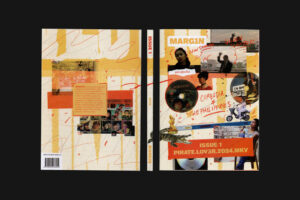TO explore the peripheries of cinema in Southeast Asia, one would have to trace histories and feel for gaps in the words and images that have already been created on the region’s cinematic pulses.
For writer-editors Savunthara Seng and Alyssandra Maxine and designer-art director Sonich Touch, their independent film magazine MARG1N takes on this daunting task — all while weaving together marginal filmmaking and film-viewing narratives of their countries, Cambodia and the Philippines.
Their first issue, titled pirate.lov3r.2024.mkv, tackles the culture of piracy.
“To some degree, I want to push forth with MARG1N to intertwine film more with the general public. Not in the sense of ‘watch films to make you smarter,’ but more like ‘why not watch this because it’s a fun thing?’,” Ms. Maxine said at the Manila launch of the magazine on June 7.
By raising questions on viewing habits, which include downloading, stealing, and sharing, film piracy as an inevitable part of film culture can be addressed.
Between Cambodia and the Philippines, MARG1N’s first issue contains 20 pieces interlacing each other. Essays, analyses, fiction, comics, and photographs come from various Cambodian and Filipino filmmakers, actors, critics, and viewers, making up 120 pages.
Putting it together is a challenge, according to editor-in-chief Mr. Seng.
“Throughout the nine-month process of putting things together, for me, the most important thing I learned is the collaboration process. It’s easy to have people write but to actually collaborate, especially if you have a small team of three people, you have to keep faith in everyone you work with,” he said in a video message shown at the launch.
He and Ms. Maxine met online on the movie-tracking social media platform Letterboxd. She immediately accepted after he pitched the concept of a print-only film magazine where each issue explores the cinemas of two Southeast Asian countries.
Cambodian production company Anti-Archive serves as the official headquarters of the magazine.
“I thought that I wanted to do something like [the late Filipino film critic] Alexis Tioseco’s work. I have a more literary background, so I conceptualized a human angle to piracy through the perspective of young writers,” she said.
With Mr. Seng and Ms. Touch based in Phnom Penh and Ms. Maxine based in Manila, MARG1N came to life with writers all collaborating online.
The pieces range from humorous comics about downloading movies in Cambodia to a fictional report of lost Filipino films being rediscovered from pirated copies; from articles about long-forgotten Cambodian films to cross-cultural dialogues between filmmakers who pirate each other’s works.
While the topic of piracy turned off many potential funders for being “bold, provocative, and somewhat reactionary,” MARG1N thrived because of sponsors that believed in the vision, like Cambodian filmmaker Davy Chou and supporters from France, Singapore, and even Mongolia.
“My most important takeaway would be to grow communities and nurture the bonds you have with people who love film, because it’s more fulfilling than any monetary reward,” Ms. Maxine said.
She said that the second issue, now accepting contributors, will center on the cinemas of Vietnam and Singapore. The topic will be “Traces.”
“We want to expand our repertoire with something more abstract. We’re dealing with countries with tight censorship and restrictions, so ‘Traces’ gives writers and artists more leeway to interpret it however they want,” she said.
MARG1N Magazine’s first issue, pirate.lov3r.2024.mkv, is available to order via https://marg1n.com/ — Brontë H. Lacsamana





